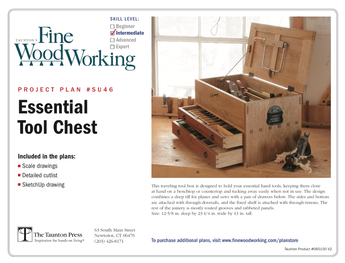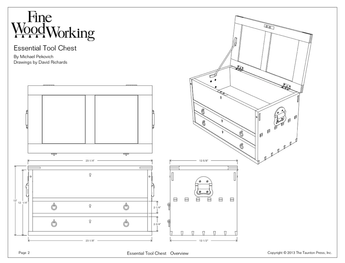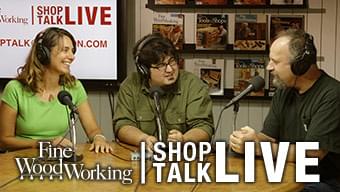Shaping a seat with through tenons in place?
I am ready to start shaping my first stool seat made out of pine with 1″ maple through tenons for the legs. From what I’ve read it seems most people shape the seat then install the legs and trim the tenons flush. I plan to use a kutzall shaping dish for the seat.
With a shaped seat I’m thinking the approach would be to dry fit the legs mark the tenons then trim the tenons just proud of the seat surface install glue and sand flush
Is there any merit to installing the legs trim flush then shape the tenons at the same time as the seat? It seem like it would be difficult to cleanly flush up the maple tenons to the concave seat shape. Would the hard maple next to the pine cause the shaping disk to catch and gouge?
Any thoughts or ideas on what is better














Replies
Ive done both. I prefer to shape before hand. After glue up I use a chisel bevel down to get the tenons close. After that an orbital or card scraper does the trick.
The shaping disc do like to grab end grain, but the kutsall much less than the turboplane. Light and slow is doable and still plenty fast.
The reason I don’t like gluing legs first is I don’t like the odd force grinding will put on the joints.
First stool seat? Test it. Make a chunk of seat, stuff a tenon through it, and test your methods. A LOT can go wrong fast using a power tool for a finess cut. Even a ROS working on the maple end can gouge the pine.
I pre-assemble just before final scraping a seat and draw the ring around each tenon. Take it apart, sawcut as close as I dare before gluing up and wedging. I use chisels to get close and the "mini travishers" in the pic below for final cleanup. (they're just 4 1/2" wide)
Those are great looking travishers MJ - are they shop-made or did you purchase them somewhere?
Bought them at the tool swap outside Fine Woodworking New England last April. The dealer told me they were originally made for shaping shoe lasts.
I'll have to get there earlier this year! Maybe I'll see you there. Thx. Mike
Thank you, that is what I thought. I dry fit the legs, marked, trimmed, and this worked quite well. The article "Build a Simple Stool" in FW indicated he trimmed the tenons after glue up, which on a sculpted seat seemed problematic to me. The shaping disk worked very nicely but I hate it, I think I need to play with some travishers.
This build is a test run with some wood I have on hand, I'm working towards building a chair out of cherry with a simple post and sculpted back but similar base structure. I made the tenons using a round over router bit which worked ok but it took a lot of finesse so I need to develop a different approach for that.
RE "tenon flush with the seat"
what "look" are you going for? Old school Windsor or more modern "everything sanded" look?
If Old School Windsor, you want those tooling marks as they are part of the look. Get a good gouge (for example Pfeil 40mm, #7 or 8 Sweep) and its no problem at all removing the stubs of the tenon after you cut it with a flush cut hand saw. Just carve towards the center of the tenon, never away from the center (which are cause tear-out from un-supported wood fibers). Tap-tap-tap with that sharp gouge and its gone in a few minutes, with a very nice "finished with a hand tool" look.
Honestly, this is one of the most satisfying parts of building a chair.
Also, make sure you are reaming this joint. Reaming is an extra step (on both the mortise and the tenon), but the strength it puts into that joint is massive. I highly recommend you ream and wedge these joints. Remember, 200+ lbs of force could be acting on these 5/8" joints for several hundred years of use (thumbs up that the chair lasts that long!). All the glue in the world will not stand up like a mechanical joint that is reamed and wedged.
I really like the idea of reaming the joint. I ordered a reamer and tenon cutter from lee valley to play with. The pull shave looks very promising but will have to put that in a future budget.
Thank you all again
Yes, grinding disc like the kutzall, or even cutting disc like the turbo plane, suck to use.
To quote Curtis Buchanon, "They don't bring any joy to my day so I don't use 'em".
A good travisher isn't hard to find, but an entry level aka cheap one is. There are versions like soleshaves, spoonbottom planes, etc that will work, but they lack the efficiency of a travisher made by Windsor Workshop, Elia, or Galbert.
So maybe keep grinding until you decide you really wanna make more chairs and then go for a travisher. You can find an inshave or scorp for $75 or so. I think I'd prefer that to a gouge, although a gouge might be more useful overall when overlapped with other details.
I mean people use routers, tablesaws, adzes, cushions to solve, so definitely some solutions out there without buying too much if you keep playing around with it.